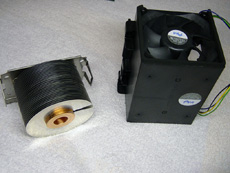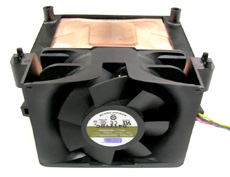Intel's Long Awaited BTX Form Factor
by Purav Sanghani on November 15, 2004 5:31 AM EST- Posted in
- Cases/Cooling/PSUs
BTX Cooling and Airflow
Again, the main reasoning behind Intel during the redesign of the ATX form factor was to design a more efficient cooling solution. As components are built faster they also run hotter. The ATX form factor improved on the AT specifications by placing the CPU closer to the back of the case where fans could be mounted as exhausts to pull hot air from the CPU out of the chassis and away from other components. Now that those other components in PCs are beginning to expand in performance and functionality they are running at temperatures as high as that of CPUs so a new design needed to be devised to help cool these components in a more efficient manner than just slapping more fans in a standard case. Now, we have come full circle with the CPU moving back towards the front of the case. Since Intel has the standards on PCIe very heavily controlled, worrying about PCIe cards extending too far to the front of the case should not be a problem.Intel implements a more efficient passive cooling system by placing the majority of components inline with the CPU towards the rear of the chasis.
 Click to Enlarge |
 Click to Enlarge |
The most important piece of hardware when it comes to cooling is the CPU heat sink fan. Without this a CPU would not POST, and would most likely damage the hardware. Intel has included what it calls a "BTX Thermal Module" which consist of either a spiral or stacked-fin heatsink and a fan which is mounted at the end of a plastic duct, facing the front end of the case. Intel has not limited this hardware to only one type though. In their virtual press kit Intel speaks of Type I (Standard height) and Type II (Low profile) thermal modules. The Type I module will be designed for a broader range of cases from small form factor to the larger full tower applications while the Type II module will be designed specifically for the ultra-small form factor designs.
 Click to Enlarge |
 Click to Enlarge |
Intel also mentioned that along with those two types of thermal modules there will be variations in the units for processors rated at different Thermal Design Power, or TDP levels. The difference in modules will exist mainly with the heatsink, with slight variations in the duct. The fan will, however, remain the same within the same type (Type I/Type II) of module.
This thermal module was the only piece of cooling hardware aside from the power supply which we found to be surprising. We couldn't imagine running an ATX case with only one CPU heatsink fan and we have our doubts about Intel's single module design, but we will leave that to our benchmarks to decide.










77 Comments
View All Comments
ThelvynD - Monday, November 15, 2004 - link
We've been getting in new HP 7100s here at my work center and they've been in the micro-BTX format. I don't any major problems with it so far. Pic below.http://www.picsplace.to/044712/HP-BTX.JPG
Nonsense - Monday, November 15, 2004 - link
#36 - Thanks Purav.Can you tell me - is the PS blowing in or out, and is the CPU fan blowing in or out? I'm still trying to figure where all the air is comming from.
PuravSanghani - Monday, November 15, 2004 - link
#34: If you look at the picture of the backside of the B300 on page 8 there are groups of holes above the VGA expansion slot as well as to the right between the expansion slot and the power supply. There are also holes lining the bottom of the case if you look closely. We were surprised ourselves to find how well passively cooling all of the components in a system would actually work. And from the pictures you can also see there aren't too many holes for a large amount of air to come in through!PuravSanghani - Monday, November 15, 2004 - link
#25: Actually, the front panel connectors *are* standardized and combined into one single plug. We mentioned this on page 8 of the article, "First Look: AOpen B300 BTX case cont'd", in the paragraph where we talk about the auxiliary module.Nonsense - Monday, November 15, 2004 - link
#28 - I don't understand the air flow.If the CPU fan is blowing out the front of the case, then the PS _must_ be blowing in.
Blowing hot air into a case does not sound good. Is that how it works?
If the PS is also blowing out, then you have a vacuum. I do not see any heat comming into the case from the PS, so it must be blowing out...?!
Where is the air comming from that is cooling the graphics card? It looks like mostly dead air in that corner - there are only tiny grills on the back.
Sunbird - Monday, November 15, 2004 - link
From last paragraph of article:"The ATX case used more space and ran louder."
Space is not evil!, its a good thing for when your drop a small screw, or have hands that fit your 6'6" frame. And loudness can be adressed in other just as succesfull ways.
"Don't forget that additional non-redundant fans increase the failure rate of a computer as well - more moving parts."
And what if the single fan on the BTX sollution fails? That is really non-reduntant if you ask me, anyone agree?
Sunbird - Monday, November 15, 2004 - link
#20, I agree, I have a Packard Bell P1 133MHz flat desktop case PC in my workshop and that is almost exactly the same design as this, except the stuff like the optical drive, hard drives and power supply was swapped from the right to the left side of the case, othewise its exactly the same. Glad to see some oldschool designs again, lol#27's idea is brilliant, they quickly implemented something like that with the cases and their front USB options, those LED and power button connector have been around much longer. What's taking them so long?
epiv - Monday, November 15, 2004 - link
skunkbuster - Monday, November 15, 2004 - link
flash in the pants?Zebo - Monday, November 15, 2004 - link
This is going nowhere quick. It's obvious Intel will no longer need it when they make the Dothan desktop transition plus AMD all case and PS manufactures hate the idea. Just wahtever you do don't go buying an $300 Lian Li and $120 PSU since BTX is a flash in the pants.